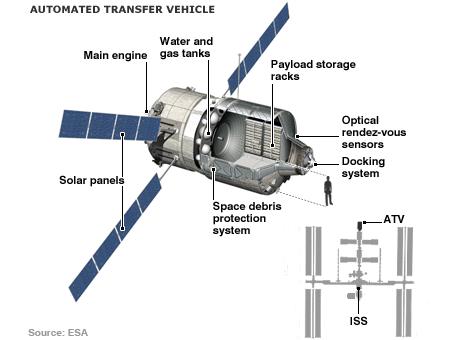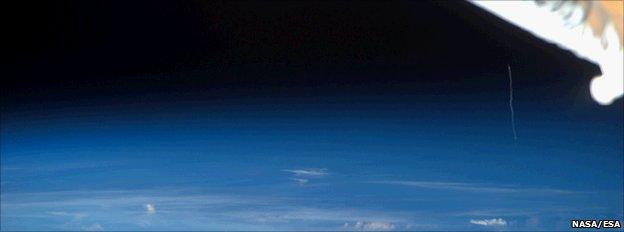'Johannes Kepler' space freighter heads to station
- Published
The Ariane rocket lifts off from Europe's spaceport in Kourou, French Guiana
Europe's space freighter, Johannes Kepler, external, has been blasted into orbit by an Ariane 5 rocket from French Guiana.
The robotic truck is heading to the space station with new supplies of food, air, fuel, and experiments, as well as other equipment.
Kepler weighed just over 20 tonnes at launch, making it the biggest payload ever lifted into the sky by an Ariane.
What is more, it was the 200th Ariane flight since the vehicle series was initiated in 1979.
Lift-off from the Kourou spaceport occurred at 18 hours, 50 minutes and 55 seconds local time (2150.55 GMT) - the instant needed to put the truck on the right path to catch the International Space Station (ISS) on Thursday next week.
"It was enormous; the mission was absolutely flawless," said an ecstatic Nico Dettmann, who heads up the freighter programme at the European Space Agency (Esa).
"It's like you've written a story and it turns out exactly the way you wanted. All the data we're getting from Kepler is positive. All the events have occurred that should've occurred, like solar panel deployment. The team has done a wonderful job and I'm really proud of them," he told BBC News.
When it gets to the station, Kepler will dock with the Russian Zvezda module on the rear of the orbiting platform.

The launch is watched from the freighter's control centre in Toulouse, France
Its arrival will allow space shuttle Discovery to lift off from the Kennedy Space Center in Florida on 25 February.
Both vehicles use the same satellite system to relay telemetry, and mission managers prefer to have only one ship at a time en route to the ISS.
Johannes Kepler - also known by the generic name of Automated Transfer Vehicle (ATV) - is the second such craft to be sent to the station by the European Space Agency (Esa).
One of its key tasks in the coming months will be to push the station to a higher altitude.
The ISS has a tendency to lose height over time as it brushes through the residual atmosphere still present 350km above the Earth, external.
Of the more than 7 tonnes of fluid and dry cargo held by Kepler, the greater part is given over to the fuel it will use in its four big thrusters to boost the station's orbit.
"We have two tonnes for the ATV mission itself and then four-and-a-half tonnes for ISS re-boost and altitude control and in case of collision avoidance manoeuvres," explained Mr Dettmann.

Kepler will become a temporary storeroom at the ISS. Astronauts will go inside to retrieve stores as and when they need them.
These include experimental items such as GeoFlow2, a box that will be used on the platform to model the convection of molten rock deep inside the Earth.
Over time, Kepler will be filled with station rubbish. In June, the ship will be commanded to undock from the ISS and take that refuse - and itself - into a destructive dive through Earth's atmosphere over a defined region of the South Pacific.
Although Esa has produced many complex scientific satellites, none matches the scale of the freighter.
Its automatic rendezvous and docking technology allows it to find its own way to the station and attach without any human intervention.
Esa believes the vehicle's capabilities will feed into many exploration activities, at the Moon, Mars and other Solar System destinations.

The astronauts on the space station saw the exhaust plume of Ariane climbing into the sky
Feasibility studies have looked at how a return capsule could be added to the service and propulsion unit of an ATV, even one capable of carrying astronauts.
The agency's member states must decide soon what to do with the concept, beyond the three further vehicles they have already ordered from European industry - either to purchase more of the same, or to evolve ATV in some way.
Simonetta Di Pippo, the director of human spaceflight at Esa, said the latter course seemed to be the logical way forward.
"The idea is to procure up to ATV-5 and then to develop a new system," she told BBC News.
"We want something new in order also to keep the expertise in our industry. We're discussing this in the context of the extension of ISS up to 2020 and beyond with our member states.
"It would be something that is a derivative of the ATV, with the requirements to be discussed with the station partners."
An artist's impression of ATV2 Johannes Kepler flying over France
- Published29 September 2010